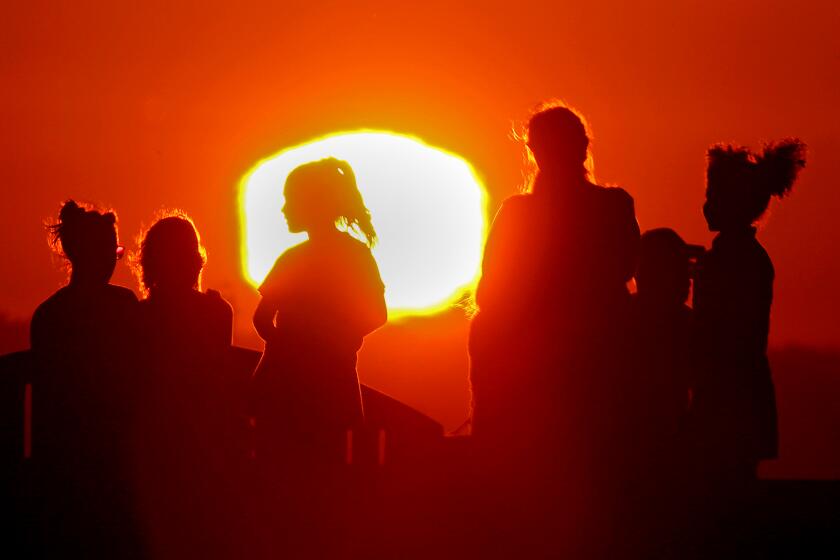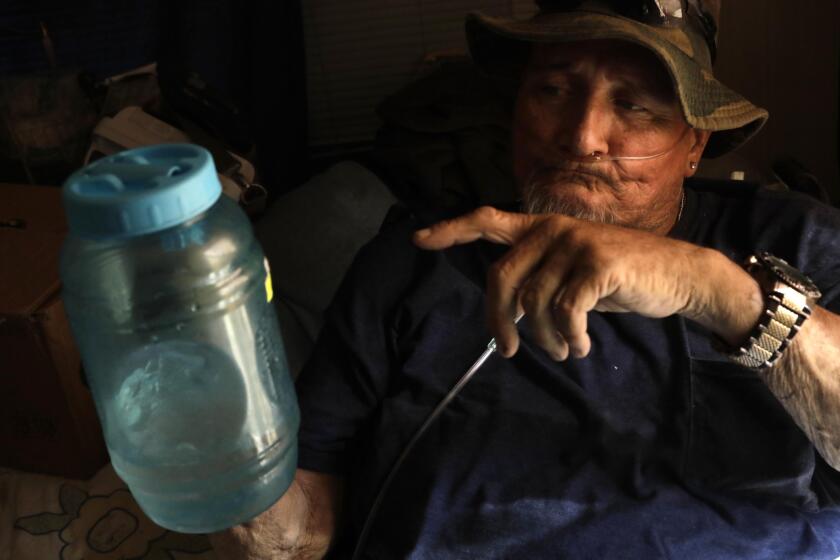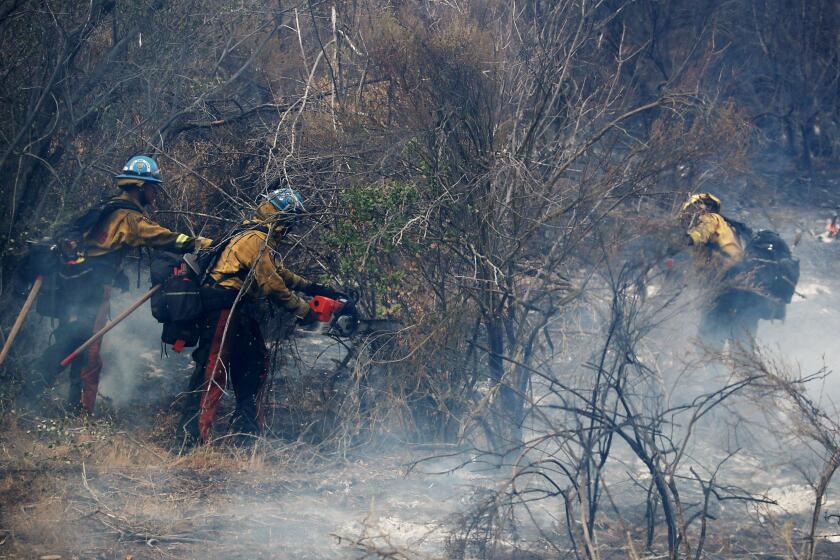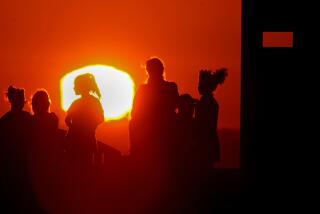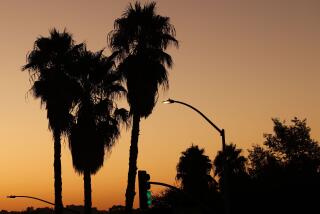Heat wave hits Southern California with a scorching Fourth of July weekend
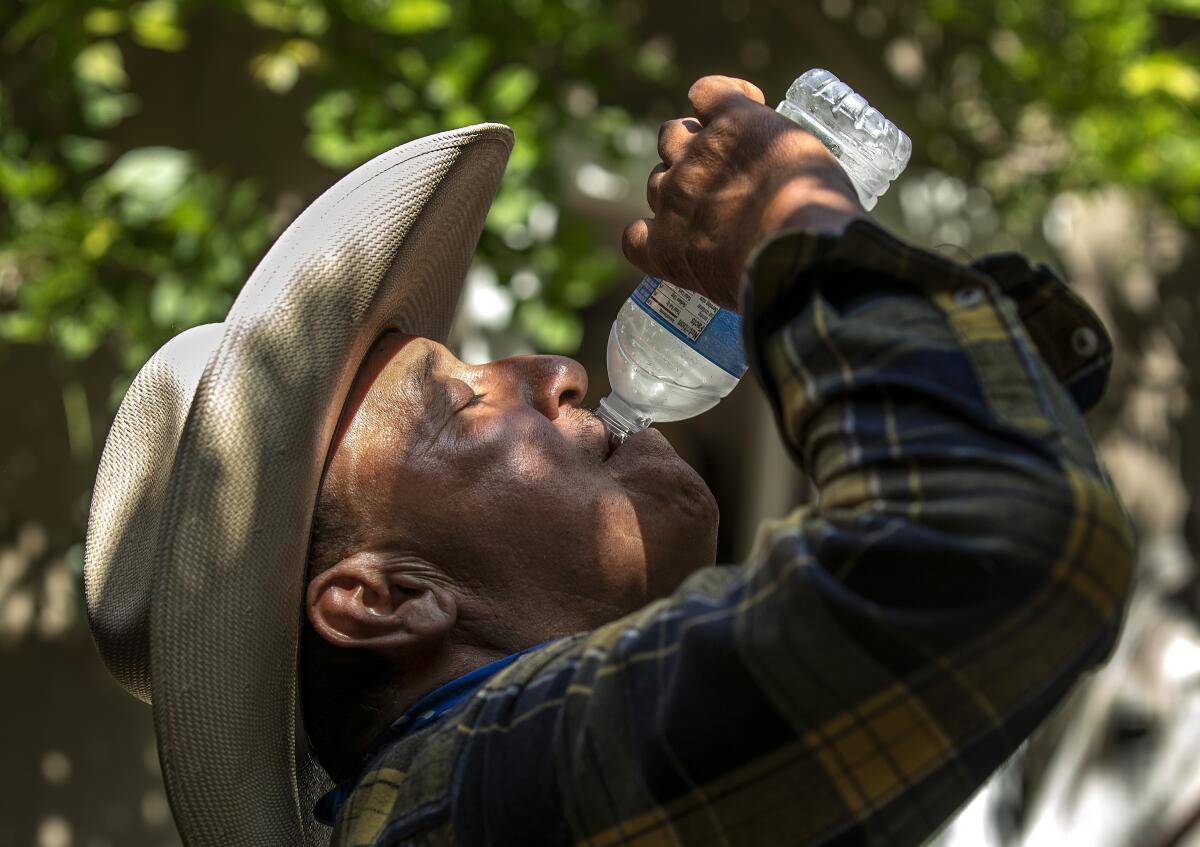
After months of persistently overcast skies and cooler conditions, Southern California is set to see its highest temperatures of the year this weekend as an oppressive heat wave blankets much of the state, as well as parts of Nevada and Arizona.
“This is the first true heat wave of the season,” said Rich Thompson, a meteorologist with the National Weather Service in Oxnard. Officials from San Diego to Shasta County are warning about heat-related illnesses and an increased fire risk as temperatures are expected to soar into the triple digits just in time for Fourth of July celebrations.
Forecasters have issued warnings of excessive, dangerous heat throughout the valleys, deserts and foothills in inland regions across the state, with little relief expected in the evenings.
In Southern California, the most extreme conditions will be in the Antelope Valley, David Gomberg, a meteorologist with the NWS, said Friday. “The desert regions are going to be hottest. We’re going to have a sharp rise today, but the hottest temperatures will be tomorrow and Sunday.”
Lancaster and Palmdale are forecast to hit highs of 107 and 110 degrees over the weekend, and much of the foothills in Los Angeles, Ventura and San Bernardino counties are also expected to reach triple-digit temperatures. The Santa Clarita Valley should expect highs up to 105 degrees.
The warnings came as state officials cautioned Californians about the increased threat of wildfires due to fireworks and drying vegetation.
Standing beneath the blistering sun at the Grass Valley Air Attack Base in Nevada County on Thursday, California Department of Forestry and Fire Protection Chief Joe Tyler said that although the wet start to 2023 may have delayed the start of fire season, it has not deterred it.
“The abundant rain has produced tall grass and other vegetation that’s dried out already and is ready to burn,” Tyler said.
Tyler likened this year’s conditions to 2017, which started similarly wet but later saw dry vegetation and strong wind events that spurred major fires. More than 1.5 million acres burned that year, he said, killing 47 people and destroying 11,000 structures.
This year, there have already been a number of small wildfires, including one in Riverside County on Tuesday that grew to 55 acres and burned at least two structures. The previous week, Cal Fire responded to more than 300 blazes statewide, Tyler said. The agency is fully staffed with fire engines, bulldozers and aircraft ready to respond at the first sign of sparks.
“As the Fourth of July is quickly approaching us, I’m asking each of you to be mindful of how quickly a fire can have devastating consequences,” he said.
Indeed, an excessive heat warning will be in effect Saturday and Sunday for the Santa Clarita and Antelope valleys, raising concerns not only about wildfires but also that hot and dry weather “will significantly increase the potential for heat-related illnesses, particularly for those working or participating in outdoor activities,” according to the National Weather Service.
Overnight lows in many places are not expected to drop below the 70s, which can create dangerous conditions, especially for those without air conditioning or certain health conditions.
Downtown Los Angeles should reach the 80s for the first time in months this weekend, snapping a historic streak of two months without crossing that threshold — the longest on record for May and June. While temperatures began to rise in the Southland on Friday, downtown’s high didn’t surpass 77 degrees, Thompson said as of Friday afternoon — stretching the record to 61 days.
“Now tomorrow, we’ve forecast a high of 83, so tomorrow we should break 80 degrees,” Thompson said.
California’s first heat wave of the year could last into next week. Here are some tips on how to stay safe and cool during hot weather.
Along the coast, temperatures should remain significantly more moderate this weekend, peaking only in the 70s, Gomberg said. But conditions a couple miles inland will be drastically warmer, with Burbank expected to reach the upper 90s.
The heat wave is hitting Northern California and the Central Valley first, with an excessive heat warning already in effect Friday until late Sunday for much of the area, including the Northern and Central Sacramento Valley, San Joaquin Valley, Kern River Valley, Indian Wells Valley, the lower Sierra Nevada foothills and much of the Mojave Desert. Temperatures across the region there are expected to reach well into the 100s, even as high as 112.
Redding on Friday already hit above 100 degrees, with temperatures expected to keep rising through the weekend. Much of the Bay Area will also see some of the hottest days this year, with highs expected from the low 90s to 105 degrees.
Similar conditions across much of the southeastern U.S. have left that region also under a blanket of oppressive heat, though there it has already dragged on for days.
The worst of California’s heat is expected to be short-lived, though, with temperatures dipping slightly by the Fourth of July, Gomberg said.
Read all of our coverage about how California is neglecting the climate threat posed by extreme heat.
Monday will still be very warm over the interior but not quite as hot as the weekend, with most places forecast to see a temperature drop of about five degrees by Monday.
“Fourth of July itself we’ll see further cooling, returning closer to normal for this time of the year,” Gomberg said. Most of the high deserts and foothills are forecast to drop into the 90s.
But even as temperatures dip, he said, the concern about wildfires will remain, as low humidity, high temperatures and more outdoor and risky activity from the holiday weekend form significant risk factors.
“There is an elevated threat for larger fires,” Gomberg said.
Gov. Gavin Newsom and California fire officials outline plans for ‘peak’ fire season.
The threat is so significant that Gov. Gavin Newsom joined Cal Fire officials in Grass Valley to outline a war-like strategy for responding to blazes this season and in the years ahead.
“We live in this new reality where we can’t necessarily attach ourselves to some of the more predictive models of the past because of the nature of a world that’s getting a lot hotter, a lot drier and a lot more uncertain as it relates to the issue of climate change,” Newsom said.
Among the state’s latest tools is the Fire Integrated Real Time Intelligence System, or FIRIS, which includes advanced aircraft than can deliver real-time updates on fire behavior to crews on the ground.
For the second year in a row, the state will also deploy “Fire Hawks” — modified Black Hawk helicopters that can fight fires at night.
“It has been a game-changer,” said Benjamin Berman, chief pilot of Cal Fire’s helicopter program. The Fire Hawks “can seamlessly transition from fire suppression to hoist-air rescue to vegetation management without any further configuration.”
What’s more, the state’s firefighting portfolio now has about 1,000 mountaintop cameras that can provide real-time, 360-degree monitoring of the state’s forestlands; pinpoint fire starts using artificial intelligence; and help organize resources for early suppression, Newsom said. Just a few years ago, such monitoring had to be conducted by people in towers.
Fire weather is slightly less of a concern in the San Joaquin Valley because so much of the region has remained moist from this year’s record-breaking southern Sierra Nevada snowfall, said Dan Harty, a meteorologist with the weather service in Hanford.
Though the snowpack is beginning to dwindle, there is still a chance for high stream flows and snowmelt driven by the heat wave, he said.
“There’s not a whole lot left, but it’ll cause some increases in area rivers and streams,” Harty said. That includes the Walker River in Mono County, which may see some flooding, and the Merced River in Yosemite Valley, which is likely to swell but not flood.
But though wildfire poses a persistent threat to Californians, so, too, does extreme heat. Despite the holiday, officials this week reminded people vulnerable to extreme heat — including children, the elderly, pregnant people and people with chronic health conditions — to reduce time spent outdoors as much as possible.
More to Read
Sign up for Essential California
The most important California stories and recommendations in your inbox every morning.
You may occasionally receive promotional content from the Los Angeles Times.
